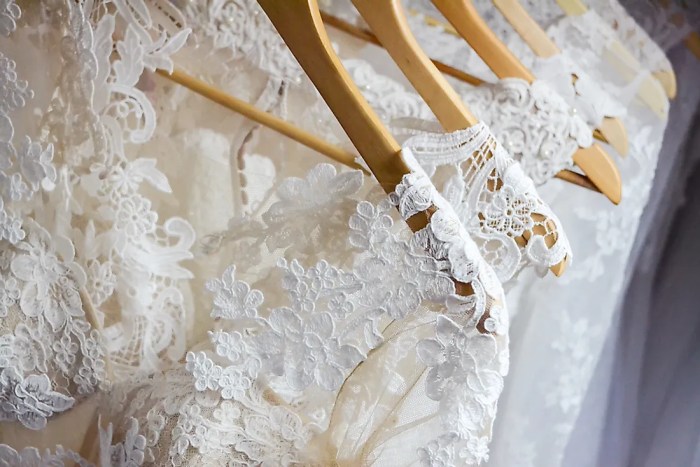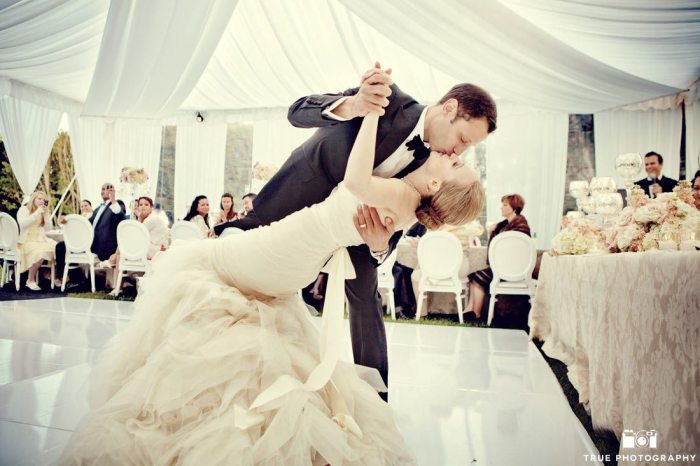Queen Victoria’s Impact on Bridal Fashion
Origins of white wedding dress – Queen Victoria’s choice of a white wedding gown in 1840 dramatically altered the course of bridal fashion. Before her, wedding attire varied widely depending on social class and regional customs, with white not holding any particular significance. Victoria’s decision, however, propelled white to become the dominant color for bridal gowns, a tradition that persists to this day. This shift reflects broader societal changes and the evolving symbolism associated with wedding attire.
Queen Victoria’s White Wedding Dress
Queen Victoria’s wedding dress, made of Honiton lace over white satin, was a departure from the prevailing fashion of richly colored gowns adorned with elaborate embellishments. This seemingly simple choice, however, resonated deeply with the public, establishing a new standard of bridal elegance. The publicity surrounding the royal wedding, amplified by burgeoning print media, ensured the widespread dissemination of images of the Queen in her white gown.
This visibility solidified white as the preferred color for brides across social strata, although accessibility varied greatly.
Societal Shifts and Changes in Wedding Attire, Origins of white wedding dress
The adoption of the white wedding dress coincided with a broader shift in Victorian society towards emphasizing domesticity and purity. White, already associated with virtue and innocence, became powerfully symbolic of a bride’s purity and her transition into marriage. The shift away from colorful, ornate gowns reflected a move towards a more restrained and idealized image of the bride.
Comparison of Victorian and Pre-Victorian Wedding Dresses
Pre-Victorian wedding dresses were far more diverse in color and style. Wealthy brides might wear elaborate gowns in vibrant colors such as red, blue, or gold, signifying prosperity and status. Poorer brides often wore their best dress, regardless of color, reflecting practicality over symbolic meaning. The choice of fabric also indicated social standing; silks and velvets were reserved for the wealthy, while simpler fabrics like linen or wool were used by those of lower social classes.
Victoria’s white gown marked a significant departure from this tradition, ushering in an era of standardized bridal attire.
Pre-Victorian Wedding Attire
Before Queen Victoria’s influence, wedding attire reflected a broader range of cultural and social norms. Color and fabric choices held different meanings, and the concept of a universally “white” wedding dress simply didn’t exist. Different regions and social classes exhibited diverse traditions in bridal wear.
Wedding Attire Across Cultures and Historical Periods
Examples of pre-Victorian wedding attire demonstrate the diversity of customs. In some cultures, vibrant colors like red (symbolizing good fortune in many Asian cultures) or blue (representing loyalty in some European traditions) were common. In others, practical considerations dictated the choice of clothing; a bride might wear her finest everyday attire, regardless of color or material. The fabrics used varied widely depending on availability and social standing, ranging from simple linens to luxurious silks and brocades.
Pre-Victorian Wedding Dress Comparison Across Social Classes
| Social Class | Typical Fabric | Common Colors | Symbolic Meaning |
|---|---|---|---|
| Upper Class | Silk, Velvet, Brocade | Red, Blue, Gold, Green | Wealth, Status, Prosperity |
| Middle Class | Wool, Linen, Cotton | Various, often best available dress | Practicality, social standing |
| Lower Class | Linen, Wool | Various, often muted tones | Practicality, availability |
| Rural Communities | Locally available fabrics (wool, linen, etc.) | Often muted, natural tones | Local customs, practicality |
Symbolism of White in Wedding Attire
The association of white with purity, innocence, and virginity in Western cultures is a relatively recent development, significantly influenced by Queen Victoria’s choice. While white has held symbolic meaning in various contexts throughout history, its connection to bridal attire is a specifically Western, and relatively modern, phenomenon.
Evolution of White’s Symbolism
While white has long been associated with light and purity in some religious contexts, its prominent role in bridal fashion is largely a product of the Victorian era and its emphasis on idealized femininity. The association of white with virginity specifically gained traction during this period, although this interpretation isn’t universally shared across cultures.
White vs. Other Cultural Traditions

Source: azazie.com
Many cultures associate different colors with marriage and good fortune. Red, for example, is a common color in many Asian wedding traditions, symbolizing joy, prosperity, and good luck. Similarly, other colors hold significant meaning in various cultural contexts, highlighting the Western-centric nature of the white wedding dress tradition.
The Rise of Mass Media and its Impact
The proliferation of mass media, particularly magazines and photography, played a crucial role in popularizing the white wedding dress. The ability to widely disseminate images of brides in white gowns significantly impacted public perception and established the trend as a social norm.
Dissemination of Images and Public Perception
Early photography and print media allowed for the reproduction and distribution of images of stylish brides in white dresses. Fashion magazines, increasingly popular during the late 19th and early 20th centuries, featured these images prominently, influencing bridal fashion across social classes. This visual reinforcement solidified white as the ideal color for wedding gowns.
Timeline of the White Wedding Dress Trend
A timeline illustrating the spread of the white wedding dress trend through mass media would show a clear acceleration after Queen Victoria’s wedding in 1840. The impact of photography and print media becomes increasingly evident as the 20th century progresses, with the trend solidifying its position as the dominant style in bridal fashion.
Economic Factors and Accessibility: Origins Of White Wedding Dress
The accessibility of white wedding dresses has always been tied to economic factors. The cost of materials, such as fine fabrics like silk or lace, and the labor involved in creating elaborate gowns, significantly impacted who could afford a white wedding dress. This created a disparity in bridal attire across socioeconomic groups.
Availability of Materials and Manufacturing

Source: worldatlas.com
The availability of materials like white satin and lace, along with advancements in manufacturing techniques, influenced the adoption of white dresses across different socioeconomic groups. As mass production became more prevalent, the cost of white dresses decreased, making them more accessible to a wider range of brides.
Hypothetical Scenario: Cost and Accessibility
A hypothetical comparison of the cost and accessibility of a white wedding dress across different eras would highlight the dramatic shift from a luxury item available only to the wealthy to a more widely attainable garment. A Victorian-era silk and lace gown would be prohibitively expensive for most, while a modern mass-produced gown is significantly more affordable, albeit still varying greatly in price depending on design and materials.
Modern Interpretations of the White Dress
Modern white wedding dresses showcase a remarkable diversity of styles and designs, while still retaining the core concept of a white gown. Designers have incorporated various cultural influences and contemporary trends, resulting in a broad spectrum of options for brides.
Evolution and Cultural Influences
Contemporary white wedding dresses demonstrate a wide range of silhouettes, embellishments, and fabrics. Designers often incorporate elements from various historical periods and cultural traditions, creating unique and personalized gowns. This reflects the evolution of the white wedding dress from a single, idealized style to a diverse range of expressions.
Impact of Modern Fashion Trends
Modern fashion trends continue to influence the design and popularity of white wedding dresses. The incorporation of contemporary silhouettes, fabrics, and embellishments keeps the white wedding dress relevant and appealing to modern brides. The continued popularity demonstrates its enduring symbolic significance and adaptability to changing aesthetics.
Illustrative Examples of Historical Wedding Dresses
Several historically significant wedding dresses offer insights into the evolution of bridal fashion and the changing social contexts surrounding marriage. These gowns, each unique in their design and materials, provide a tangible representation of the historical trends discussed.
Example 1: Queen Victoria’s Wedding Dress (1840)
Queen Victoria’s Honiton lace gown over white satin established the white wedding dress as a standard. Its relatively simple design, compared to pre-Victorian gowns, marked a shift towards a more restrained and idealized image of the bride. The dress’s craftsmanship was exquisite, reflecting the high standards of Victorian-era lacemaking. The impact of its simplicity and elegance on future bridal styles cannot be overstated.
Example 2: Grace Kelly’s Wedding Dress (1956)
Grace Kelly’s wedding dress, designed by Helen Rose for MGM, became an iconic symbol of Hollywood glamour and classic bridal style. The dress, made of ivory silk faille with rose point lace, embodied elegance and sophistication. Its long sleeves, high neckline, and full skirt reflected the fashion of the mid-20th century, yet still maintained the core concept of the white wedding dress.
Example 3: Diana, Princess of Wales’ Wedding Dress (1981)
Diana, Princess of Wales’s wedding dress, designed by David and Elizabeth Emanuel, was a dramatic and voluminous gown that captured the public’s imagination. Made of antique ivory silk taffeta with 10,000 pearls and sequins, the dress was both extravagant and romantic. Its puff sleeves, large train, and overall grandeur reflected the grandeur associated with royal weddings and helped to further solidify the iconic status of the white wedding dress.
Popular Questions
What are some common misconceptions about the white wedding dress?
One common misconception is that white has always symbolized purity and virginity in wedding attire. This association is largely a product of Victorian-era influences; historically, many cultures used different colors for weddings.
How has the design of the white wedding dress changed over time?
The design has evolved significantly, from simpler, less elaborate styles in the Victorian era to the diverse range of silhouettes, fabrics, and embellishments seen today. Modern designs often incorporate influences from various cultures and fashion trends.
Are there any notable exceptions to the white wedding dress tradition?
Yes, many cultures have and continue to utilize different colors and styles for wedding attire, reflecting unique cultural beliefs and traditions. The white wedding dress is primarily a Western tradition.



